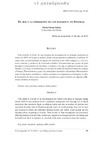Please use this identifier to cite or link to this item:
https://accedacris.ulpgc.es/jspui/handle/10553/7476
| DC Field | Value | Language |
|---|---|---|
| dc.contributor.author | Llevot Calvet, Nuria | en_US |
| dc.date.accessioned | 2012-05-30T04:00:30Z | |
| dc.date.accessioned | 2018-03-14T08:00:23Z | - |
| dc.date.available | 2012-05-30T04:00:30Z | |
| dc.date.available | 2018-03-14T08:00:23Z | - |
| dc.date.issued | 2010 | en_US |
| dc.identifier.issn | 0213-0610 | en_US |
| dc.identifier.uri | https://accedacris.ulpgc.es/handle/10553/7476 | - |
| dc.description.abstract | Este artículo es fruto de una estancia de investigación en Senegal, realizada en marzo de 2009, en la que se analizó, desde una perspectiva cualitativa y mediante 10 entrevistas en profundidad, la figura del marabout como líder religioso y, a la vez, como maestro y profesor de la escuela coránica. Son personas que gozan de gran prestigio social; pueden ser hombres y mujeres a los que se atribuyen poderes espirituales y a los que, normalmente, los jóvenes les piden la bendición antes de emigrar a Europa. Presentaremos, pues, los principales resultados del trabajo diferenciando entre los llamados verdaderos y falsos marabouts, la emigración en Senegal y el rol y la formación de éstos como maestros y profesores, para concluir con algunas reflexiones abiertas al respecto. | en_US |
| dc.description.abstract | This article is a result of an investigation stay which took place in Senegal, during March 2009. It was analyzed from a qualitative perspective and through ten in-depth interviews, the marabout figure as religious leader and also as teacher of primary and secondary Koranic school. Marabout people enjoy of social prestige, they can be men and women to which are attributed spiritual power and which youth people ask for blessing before migrating to Europe. Main results of that investigation are presented, differing between real and false marabouts, migration in Senegal and the role taking and formation of them as teachers, to conclude with some comments about the subject. | en_US |
| dc.format | application/pdf | es |
| dc.language | spa | en_US |
| dc.relation.ispartof | El Guiniguada | en_US |
| dc.source | El Guiniguada. Las Palmas de Gran Canaria: Servicio de Publicaciones, Universidad de Las Palmas de Gran Canaria, 1984 [ISSN 0213-0610], n.19, 2010, p. 43-60 | en_US |
| dc.subject | 58 Pedagogía | en_US |
| dc.subject.other | Marabout | en_US |
| dc.subject.other | Madrasa | en_US |
| dc.subject.other | Tâlibé | en_US |
| dc.subject.other | Profesor | en_US |
| dc.subject.other | Teacher | en_US |
| dc.title | El rol y la formación de los marabouts en Senegal | en_US |
| dc.type | info:eu-repo/semantics/article | en_US |
| dc.type | Article | en_US |
| dc.compliance.driver | 1 | es |
| dc.identifier.absysnet | 235347 | - |
| dc.identifier.crisid | - | |
| dc.investigacion | Artes y Humanidades | en_US |
| dc.rights.accessrights | info:eu-repo/semantics/openAccess | es |
| dc.type2 | Artículo | en_US |
| dc.utils.revision | Sí | en_US |
| dc.identifier.supplement | - | - |
| dc.identifier.supplement | - | - |
| dc.identifier.supplement | - | - |
| dc.identifier.ulpgc | Sí | en_US |
| dc.contributor.buulpgc | BU-EGB | en_US |
| dc.description.sellofecyt | Sello FECYT | |
| dc.description.esci | ESCI | |
| dc.description.erihplus | ERIH PLUS | |
| item.fulltext | Con texto completo | - |
| item.grantfulltext | open | - |
| Appears in Collections: | Guiniguada. 2ª Etapa. n.19, 2010 Artículos | |
Page view(s)
162
checked on Nov 9, 2024
Download(s)
1,472
checked on Nov 9, 2024
Google ScholarTM
Check
Share
Export metadata
Items in accedaCRIS are protected by copyright, with all rights reserved, unless otherwise indicated.
